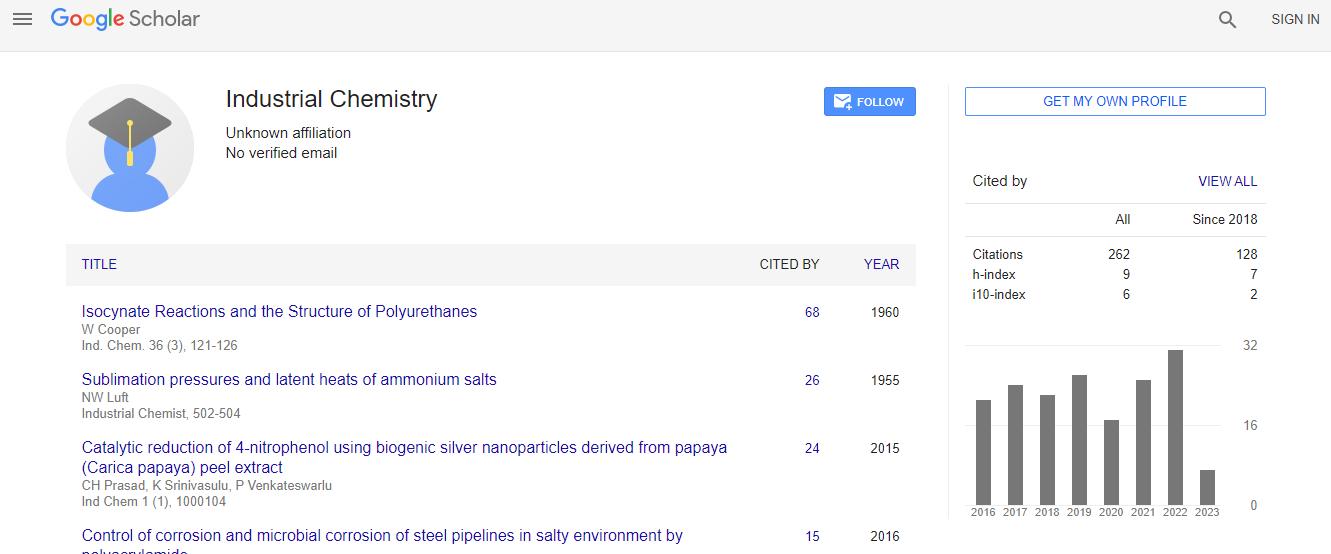Our Group organises 3000+ Global Conferenceseries Events every year across USA, Europe & Asia with support from 1000 more scientific Societies and Publishes 700+ Open Access Journals which contains over 50000 eminent personalities, reputed scientists as editorial board members.
Open Access Journals gaining more Readers and Citations
700 Journals and 15,000,000 Readers Each Journal is getting 25,000+ Readers
Google Scholar citation report
Citations : 262
Industrial Chemistry received 262 citations as per Google Scholar report
Indexed In
- Index Copernicus
- Google Scholar
- RefSeek
- Directory of Research Journal Indexing (DRJI)
- Hamdard University
- EBSCO A-Z
- OCLC- WorldCat
- Scholarsteer
- Geneva Foundation for Medical Education and Research
- Euro Pub
Useful Links
Recommended Journals
Related Subjects
Share This Page
Identification of genotoxicity in bioindicators produced by wastewater used for agricultural irrigation
17th International Conference on Industrial Chemistry and Water Treatment
Perez-Nava Jessica, Hernandez-Aldana F, Rivera-Tapia A, Martinez-Valenzuela C, Tamariz-Flores V and Huerta-Lara M
Benemerita Autonomous University of Puebla, Mexico Universidad Aut√?¬≥noma de Occidente, Mexico
Posters & Accepted Abstracts: Ind Chem
Abstract
Population growth, industrial development, intensified agricultural production and the number of contaminants incorporated into the environment have deteriorated the water compartments, it is necessary to develop strategies to reduce and prevent their contamination. In some types of wastewater, products resulting from the biological treatment process (non-biodegradable) may have significant toxicity and high genotoxicity. Genotoxicological effects may manifest at different levels, from subcellular structures or enzyme systems, to whole organisms. The unicellular electrophoresis/Comet assay (EC) and micronucleus are sensitive methodologies, available, cheap and applicable to any cell type to measure DNA strand breaks in individual cells considered as assays indicative of premutagenic lesions. The evaluation of abnormal cells was performed in producers using treated wastewater for agricultural irrigation. The presence of nuclear and micronuclei abnormalities in the identified cells was classified in relation to their nuclear form by observing degenerative nuclear changes related to cellular toxicity. Among the nuclear abnormalities detected in the producers prevail the condensed and binucleated cell nuclei, without observation of more than six micronuclei per thousand cells counted; however, tests on bioindicators (Allium sativum and Vicia faba) will be carried out to confirm genotoxicity levels generated by the compounds present in the wastewater.Biography
Perez-Nava Jessica has completed her MSc from Benémerita Universidad Autónoma de Puebla. Currently, she is pursuing her Doctoral program in the same university. Her research areas include: photochemical treatment of wastewater, genotoxicity and microbiological tests. She has published two scientific papers and has made academics mobilities in Mexico and abroad.
Email:jesyolpris_1@hotmail.com

 Spanish
Spanish  Chinese
Chinese  Russian
Russian  German
German  French
French  Japanese
Japanese  Portuguese
Portuguese  Hindi
Hindi 